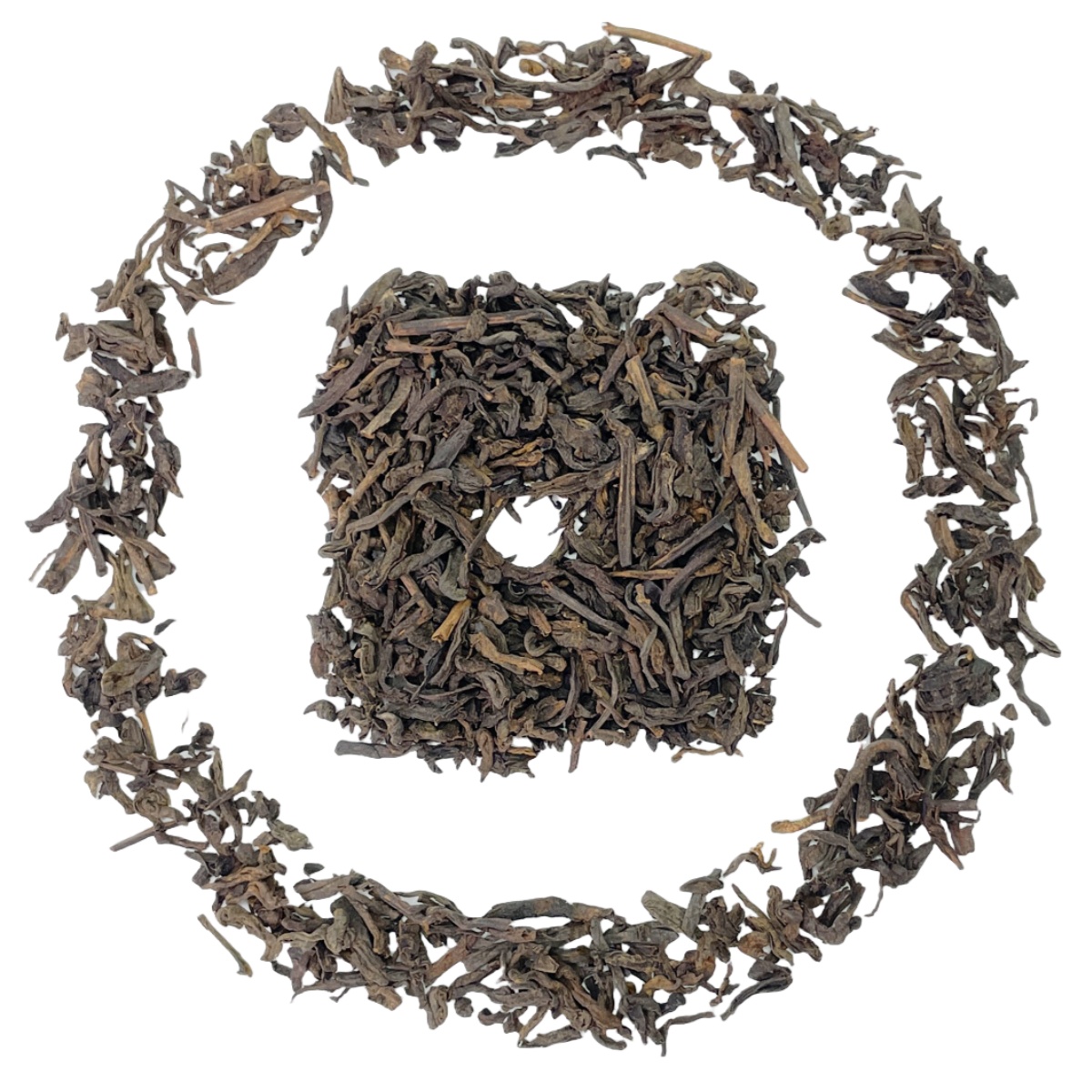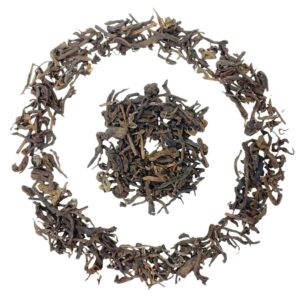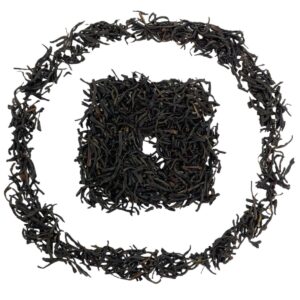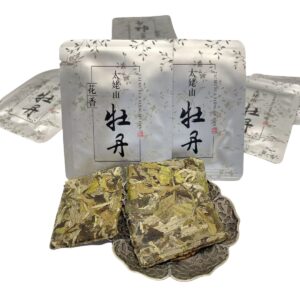Description
Liubao Tea: China’s Former Royal Tribute Treasure
Liubao tea, a representative of traditional Chinese dark tea, originates from Liubao Town, Cangwu County, Wuzhou City, Guangxi, named after its place of origin. Its history dates back to the Ming Dynasty (around 1405). During the Jiaqing period of the Qing Dynasty, it was listed among China’s 24 Great Famous Teas and gained fame for its distinctive “areca nut aroma,” earning its status as a royal tribute tea.
Liubao Tea: The Lifesaving “Medicinal Tea” for Overseas Chinese in Southeast Asia During the Late Qing Era
Historically, Liubao tea was renowned for its dampness-dispelling and gastrointestinal-regulating properties. In the late Qing Dynasty, large numbers of Chinese laborers migrated to Southeast Asia. Due to the region’s humid and sweltering climate, many fell ill from. However, those who regularly drank Liubao tea rarely suffered such ailments, significantly boosting its reputation in Southeast Asia. Liubao tea was transported via the “Tea Boat Ancient Route” by waterways to Nanyang (Southeast Asia), becoming a vital “life-saving tea” for laborers to alleviate heat and dampness.
Liubao Tea: A Modern Intangible Cultural Heritage Health Tea
Liubao tea is characterized by its “red hue, rich flavor, aged aroma, and mellow taste.” Traditional processing techniques include killing-green, rolling, pile-fermentation, aging, and maturation, with pile-fermentation being the critical step that promotes the transformation of internal compounds, resulting in a robust and smooth profile. Rich in tea polysaccharides and minerals, it boasts health benefits such as dispelling dampness, relieving heatstroke, and aiding digestion, making it particularly suitable for humid climates. Revered as a “medicinal tea,” its exceptional craftsmanship and efficacy led to its inclusion in China’s National Intangible Cultural Heritage list in 2014 and its elevation to UNESCO Intangible Cultural Heritage of Humanity in 2022.
“26 Years of Silent Alchemy”
Origins: Harvested in 1998 from ancient tea trees in Wuzhou, Guangxi, crafted via the traditional “Double-Steam, Double-Press” method and aged in humidity-controlled bamboo crates (70% humidity, 23°C).
Scientific Validation: Lab-certified microbial analysis confirms its deep woody aroma and mellow complexity as hallmarks of superior aging.
Purity: Zero mustiness – a testament to pristine storage and meticulous fermentation.”Sip Timeless Elegance, Embrace Ancient Wisdom”
“Woody Symphony”: Dominant aged oak and dried fruit notes with a hint of honey sweetness.
“Velvety Richness”: 26 years of oxidation yield a silky texture and lingering caramel finish.
Gut Harmony: Probiotic fermentation supports digestion and gut health.
Antioxidant Power: High in polyphenols to combat free radicals.
Traditional Remedy: Revered in Chinese medicine for balancing body warmth and dampness.

Aged tea, due to its prolonged storage, exists in a dormant state. To prepare it for brewing, we must swiftly awaken the leaves to activate their aroma and vitality.
Quick Awakening Methods for Aged Liubao Tea:
1. Rinsing (Washing the tea)
Quickly pour boiling water into the teaware to submerge the leaves, then immediately discard the liquid. Rinse 1-2 times to remove unwanted odors, using 100°C boiling water to fully activate the tea’s vitality. Keep each rinse under 5 seconds to prevent loss of essential compounds.
- Pot Warming to Enhance Aroma (for aged tea)
Place dry tea leaves in the pot, pour boiling water over the pot’s exterior, and gently shake to release the aroma. Repeat 2-3 timesbefore formal brewing.
Liubao tea can be prepared through a variety of brewing techniques. Below are four methods I’ve listed for fellow tea enthusiasts, who may choose one based on their preferences.
Liubao Tea’s Diverse Brewing Methods:
Brewing Method1: Use a Yixing clay teapot(紫砂壶) or Guangxi Qinzhou Nixing pottery teapot(广西钦州坭兴陶壶). Preheat the teapot, then add 5 grams of tea leaves (tea-to-water ratio 1:18-20). Shake the leaves for dry awakening to release aroma. Rinse the tea leaves twice with boiling water to eliminate storage odor. For the first 5 infusions, steep for 10 seconds before pouring out the infusion. Gradually increase the steeping time for subsequent infusions.
Brewing Method2: Use a glass-lined thermos (avoid stainless steel). Rinse the tea leaves twice, then add 3 grams of tea (tea-to-water ratio 1:150-200). Steep with boiling water for 45 minutes to 5 hours. Retain the tea leaves and refill with hot water for subsequent steeping.
Brewing Method3: Use a clay pot or glass boiling pot. Rinse the tea leaves 1-2 times, then add 5 grams of tea to cold water (tea-to-water ratio 1:60-70). After boiling, reduce to low heat and simmer for 3 minutes. Replenish with boiling water when the liquid reaches 1/3 volume.
Brew-then-boil Method: Use a gaiwan/lidded teapot + tea boiling pot. Brew in the gaiwan 4-5 times until the flavor fades; transfer the tea leaves to the boiling pot, add boiling water and simmer over low heat for 5-10 minutes.
Water Temperature: Always use boiling water (100°C). Mountain spring water is ideal.

Storage Guidelines for Liubao Tea
- Cool and dark storage: Avoid direct sunlight to prevent oxidation and deterioration of tea leaves.
- Moderate ventilation: Maintain airflow while avoiding excessive ventilation (reduce airflow during high humidity).
- Odor isolation: Keep away from strong odors (e.g., kitchens, perfumes) as tea easily absorbs external smells.
- Moisture control: Maintain relative humidity at 60%-75% to prevent mold growth.
- Recommended containers: Use bamboo baskets, clay jars, or cardboard boxes (lined with cotton or kraft paper) to facilitate natural aging.
- Avoid using:
- Glass jars (light-permeable)
- Iron containers (prone to rust)
- Plastic bags (non-breathable).










